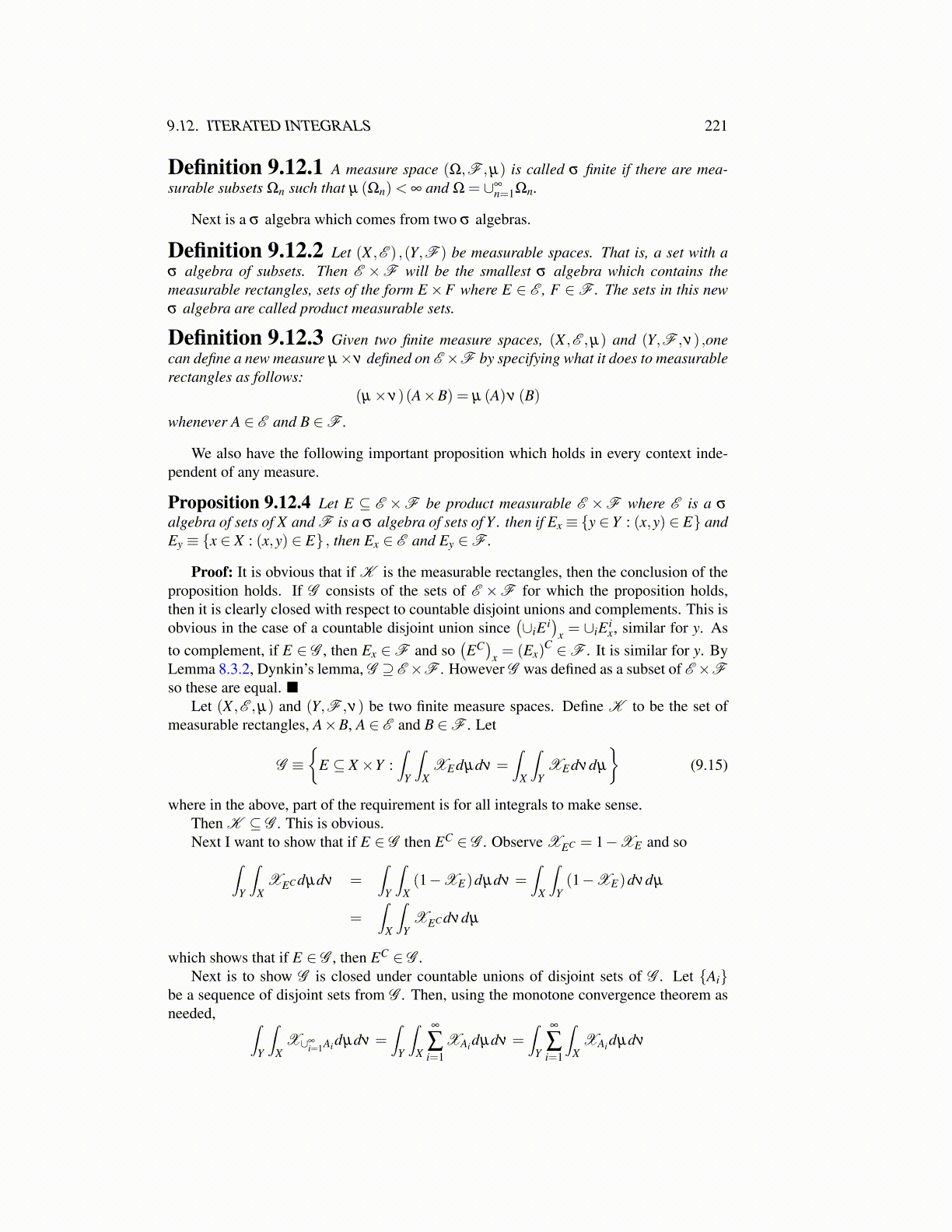
9.12. ITERATED INTEGRALS 221
Definition 9.12.1 A measure space (Ω,F ,µ) is called σ finite if there are mea-surable subsets Ωn such that µ (Ωn)< ∞ and Ω = ∪∞
n=1Ωn.
Next is a σ algebra which comes from two σ algebras.
Definition 9.12.2 Let (X ,E ) ,(Y,F ) be measurable spaces. That is, a set with aσ algebra of subsets. Then E ×F will be the smallest σ algebra which contains themeasurable rectangles, sets of the form E×F where E ∈ E , F ∈F . The sets in this newσ algebra are called product measurable sets.
Definition 9.12.3 Given two finite measure spaces, (X ,E ,µ) and (Y,F ,ν) ,onecan define a new measure µ×ν defined on E ×F by specifying what it does to measurablerectangles as follows:
(µ×ν)(A×B) = µ (A)ν (B)
whenever A ∈ E and B ∈F .
We also have the following important proposition which holds in every context inde-pendent of any measure.
Proposition 9.12.4 Let E ⊆ E ×F be product measurable E ×F where E is a σ
algebra of sets of X and F is a σ algebra of sets of Y . then if Ex ≡ {y ∈ Y : (x,y) ∈ E} andEy ≡ {x ∈ X : (x,y) ∈ E} , then Ex ∈ E and Ey ∈F .
Proof: It is obvious that if K is the measurable rectangles, then the conclusion of theproposition holds. If G consists of the sets of E ×F for which the proposition holds,then it is clearly closed with respect to countable disjoint unions and complements. This isobvious in the case of a countable disjoint union since
(∪iE i
)x = ∪iE i
x, similar for y. Asto complement, if E ∈ G , then Ex ∈F and so
(EC)
x = (Ex)C ∈F . It is similar for y. By
Lemma 8.3.2, Dynkin’s lemma, G ⊇ E ×F . However G was defined as a subset of E ×Fso these are equal. ■
Let (X ,E ,µ) and (Y,F ,ν) be two finite measure spaces. Define K to be the set ofmeasurable rectangles, A×B, A ∈ E and B ∈F . Let
G ≡{
E ⊆ X×Y :∫
Y
∫X
XEdµdν =∫
X
∫Y
XEdνdµ
}(9.15)
where in the above, part of the requirement is for all integrals to make sense.Then K ⊆ G . This is obvious.Next I want to show that if E ∈ G then EC ∈ G . Observe XEC = 1−XE and so∫
Y
∫X
XEC dµdν =∫
Y
∫X(1−XE)dµdν =
∫X
∫Y(1−XE)dνdµ
=∫
X
∫Y
XEC dνdµ
which shows that if E ∈ G , then EC ∈ G .Next is to show G is closed under countable unions of disjoint sets of G . Let {Ai}
be a sequence of disjoint sets from G . Then, using the monotone convergence theorem asneeded, ∫
Y
∫X
X∪∞i=1Aidµdν =
∫Y
∫X
∞
∑i=1
XAidµdν =∫
Y
∞
∑i=1
∫X
XAidµdν